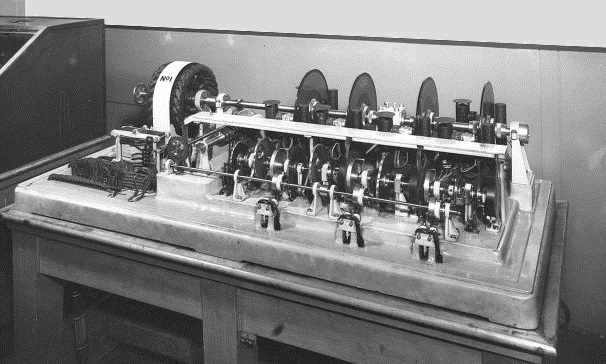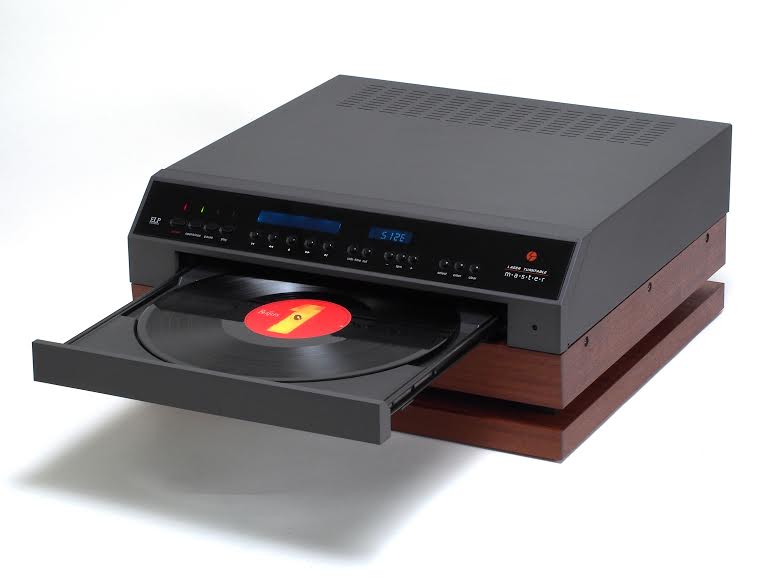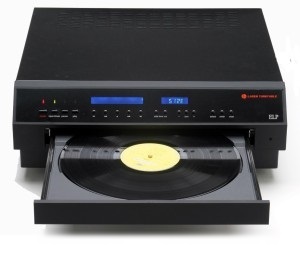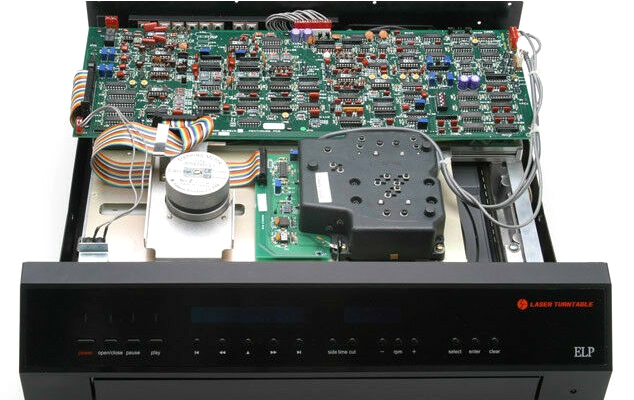
Optical replay of records

From the birth of the telephone, switchboard operators were besieged with calls asking the time.
The demand eventually became so great that the telephone companies decided that a mechanised speaking-clock would be an excellent service they could offer their subscribers — and charge for it!
A speaking-clock would require the recorded sound of a voice but clearly could not involve a medium like a gramophone (phonograph) record where the reproduction involved physical contact. The incessant, repeated playing would wear out the medium too rapidly.
The solution was to use glass discs onto which the waveforms were recorded photographically — like the soundtrack of a movie film. A bright light, shining through the discs, was intercepted by a photo-cell and converted to an audio signal. The first British speaking-clock mechanism using this technique is illustrated above.
From speaking-clocks to laughing policemen
The idea of adapting this idea to play phonograph (gramophone) discs without any physical contact using a reflected light source to sense the groove modulation is almost as old as electric recording itself.
For example, in US Patent 1,916,973 (filed 21 May 1929) a Reginald T. Friebus of the Columbia Phonograph Company, describes a system in which, ...light is shone along the grooves, and the reflection from a groove flank is detected by a (sic.) phonocell as a varying amount of light.
It is unlikely that this system provided anything but a very distorted signal, but it demonstrates the interest in the technique. And the inventors kept at it — through the age of shellac records and into the LP era.
In a US patent (US 3,138,669 filed 1961), Jacob Rabinow and Arthur Morse describe a technique in which, a beam of light (from a low-persistence CRT) is made to scan back and forth perpendicular to the LP record groove, and every time the reflection changes markedly, the direction of scan reverses. In this manner, every other reversal represents one side of the groove and those in between represent the other.
The system is thus a sampled system and time is converted to a representation of groove modulation amplitude in an integrator.
The arrival of the LASER
In 1977, William Heine presented a paper at the 57th Audio Engineering Society (AES) convention¹. It is the first modern description of a physically contact-less record player — a development which was founded on the invention of the LASER (hereafter no longer capitalised).
His paper details a method by which he employed a single 2.2 mW helium–neon laser for both tracking a record groove and reproducing the stereo audio from a phonograph record in real time.
Heine's text reads like something from the nineteenth century in its directness and lack of sanctimony. It could have been written by Edison.
After only a few short hours of playing around with the laser, a simple magnifying glass, and a phonograph record, I discovered a unique and fascinating phenomenon. By simply focusing the laser beam on a record groove, I was able to produce a brilliant arc of light, much like a red "rainbow, ' that spanned the room, across the ceiling, from wall to wall..... As I turned the record by hand, the image began to dance about in response to the groove engravings, and I recognized immediately that I had found the means to reproduce the record.
Heine had, in fact, stumbled upon the same phenomeneon which produce Buchmann Meyer patterns which have been recognised since the 1930s a direct measure of the information recorded in the grooves of the record. In the months and years that followed, Heine worked to refine his initial eureka moment into a practical record player.
Lack of physical contact deprives the optical phonograph of the simple mechanism which drags the reproducing element across the record so that it follows the groove spiral. . Like the linear tracking turntable, the sensors, motor and control system must be developed to do this; rôles which are made all the more complicated due to the lack of any physical contact as well as the irregularities (warp, eccentricity etc.) of real reccords.
Heine admitted that it took him four years to develop these systems to the point at which he could apply for a patent for first laser-scanning phonograph record player, the LASERPHONE².
Sadly, the LASERPHONE never got beyond the prototype, and it would be another 10 years before Robert Stoddart, who had studied electrical engineering at Stanford University was to file a patent³ for a laser-based turntable building on Heine's ideas.
Stoddart started a company (Finial Technology Inc.) and raised significant venture capital to develop and productionise laser record players. The Finial Technologies' design betrays a sophistication that only commercially funded R&D could achieve. A production mock-up of the Finial LT-1 (Laser Turntable-1), was completed in time for the 1986 CES.
Contemporary accounts4 report that the LT-1 design still had engineering issues but a much greater problem for the company was the disappearing market for phonograph records which had, by this time, been wholly undermined by the Sony Philips Compact Disc. What role could an - inevitably complicated and expensive - turntable play in this new digital world?
![]() So, in 1989, Finial Technologies was liquidated without ever having put the laser turntable into production and the patents were sold, ultimately ending up in the hands of a Japanese company ELP (Edison Laser Player) Corporation Japan. ELP was formed to carry on development of the turntable on the basis that there might still be enough Japanese fans and collectors of the analogue disc to justify continued development.
So, in 1989, Finial Technologies was liquidated without ever having put the laser turntable into production and the patents were sold, ultimately ending up in the hands of a Japanese company ELP (Edison Laser Player) Corporation Japan. ELP was formed to carry on development of the turntable on the basis that there might still be enough Japanese fans and collectors of the analogue disc to justify continued development.
After eight more years of dedication and development the laser turntable was finally put on sale in 1997 as the ELP LT-1XA Laser Turntable, with a list price of US$20,500.
The mature ELP product incorporates five lasers – one on each channel to track the shoulders of the groove and one on each channel to pick up the audio (which scan just below the tracking beams). The fifth laser tracks the surface of the record (the land) and keeps the pickup assembly at a constant height above the groove. See panel for information on contemporary ELP Corporation Japan laser players.
As light as light
It is often said (ELP themselves say it), that the great advantage of the laser turntable's ephemeral interaction with the disc is the lack of physical (friction-based) wear. But, unless the disc needs to be played, many, many times — as in the speaking clock — the advantage of contactless play is honestly relatively marginal.
Provided a tracking weight of less than 2 grams is used for playback and the other precautions are correctly observed (side-thrust compensation, stylus condition etc.), there is no real reason to worry that making a needle-drop recording with a conventional stylus-based player will subject the record to further unnecessary or irresponsible wear and tear.
If especially precious media are encountered, we offer techniques for scanning these records with a physical stylus which reduce the physical interaction between stylus and groove to the minimum.
In fact, it's quite likely that the record suffers more damage due to incorrect or careless storage than it will by being played occasionally with a modern, lightweight stylus.
Nevertheless, the real advantages of the optical player do derive from the massless nature of the light beam.
A massless "stylus" cannot resonate with the plastic compliance to produce a high-frequency resonance. Neither can the mass of the cartridge armature resonate with the bearing compliance. And neither resonance can be excited by groove damage or dirt.
A massless laser-beam cannot be pulled sideways in the groove to produce a side-thrust. Neither can a light beam become worn, or become clogged with lint.
A spot of laser light cannot suffer from the effects of tracing distortion or wavelength loss — its tiny dimensions may reliably follow the most convoluted curves of the groove and it may be accelerated instantaneously; without limit. It may also "run" at a different height in the groove (above the mid-point) so that it is scanning a part of the groove-wall never touched by a physical stylus the profile of which is illustrated in red in the diagram above.
A beam of light cannot transmit mechanical vibrations back into the tonearm or transmit physical sound back to the disc. And it cannot bounce the tonearm weight on the spring of its compliance.
Neither is a laser based pick-up affected by external magnetic fields or cable capacitance.
In short, a massless optical pickup has the potential to circumvent virtually all the compromises inevitable in an electrodynamic pickup; although, as in all engineering, it may introduce some of its own6.



